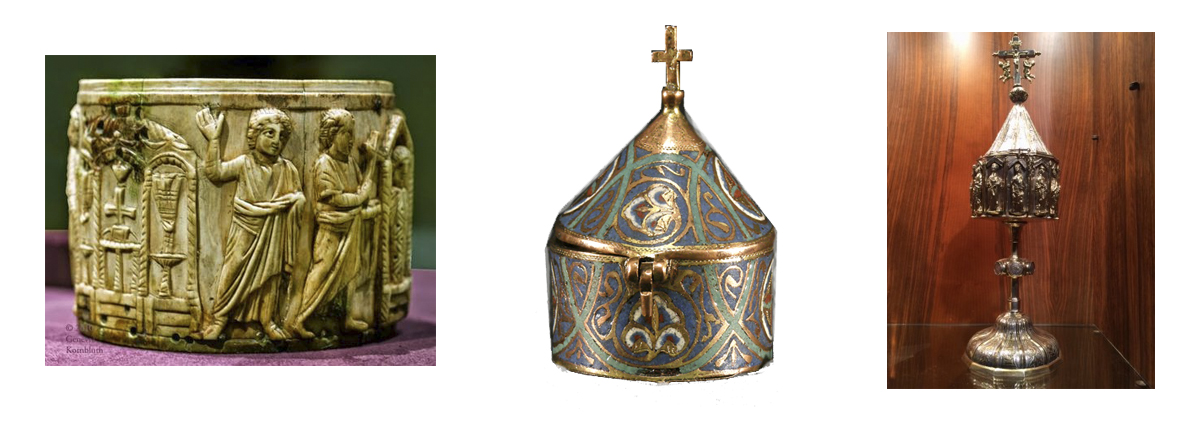The terms "tabernacle", "monstrance" and "tabernacle" define three objects of worship created for the same purpose: to contain sacred forms. Throughout the history of art they have been used interchangeably while defining their artistic peculiarities. Today we understand by "monstrance" the monstrance used for the exposition of the Form by means of the virile, and by "tabernacle" the monstrance used for the exposition of the sacred forms by means of the virile. "sagrario" to the small chamber in whose interior the consecrated forms are kept. The meaning of "tabernacle" is not so well defined and is used as a synonym for "tabernacle", or to refer to the pavilion or baldachin that covers the altar in the main chapel of temples or monasteries.
Tabernacle made by Granda for Holy Spirit Chapel in Singapore
The tabernacle in Christianity
Before the 5th century the tabernacle did not exist as such. There was, instead, the "pyxide", a sacred vessel that hung above the altar inside which the Eucharistic particles were kept. We know that this type of vessel has existed since the first centuries, since the frescoes in the catacombs of St. Callixtus, dating from around the second century, depict these simple but beautiful vessels for liturgical use.
The pyxe were not used at that time so much for worship as to keep the sacred species in the sacristy and thus be able to offer communion to the sick faithful in times of extreme need. They were small, low-capacity vessels made of noble materials: at first in boxwood or ivory and later in enameled metal.

1. V-VI century pyxes. Cleveland Museum of Art. 2. Romanesque pyx of copper and enamel from the 13th century. Diocesan Museum of Barbastro-Monzon 3. XIV century pyx of partially gilded silver. Church of San Saturnino of Pamplona
Over time, the Eucharistic species began to be reserved in a cupboard dug into the wall or inside a pillar until, finally, in the 15th century, the use of the tabernacle became widespread in churches. After the Council of Trent, a time of intense defense of the sacrament against heresies, the placement of tabernacles became generalized in all churches, often attached to the altarpiece, thus occupying the central place. In this way, the Church intended to manifest its faith in the Eucharist as a sacrifice and not as a simple commemoration.
Today the tabernacle is generally placed on the main altar, as a central element in the church.

Tabernacle made by Granda for the church of St. John the Baptist in Pushkin (Russia).
The art of making tabernacles
The tabernacles are small chambers destined to reserve the sacred species. They are built from a metallic structure that is usually later covered with gold or silver. Two parts are distinguished in it: the inner cover, where the consecrated hosts are deposited, and the outer one, which protects it and remains as a visible part. Both are usually enriched with different materials and decorative elements: engravings, enamels, jewels... that form scenes or motifs typical of Christian tradition and symbolism. Often the interior, which is kept hidden, is richer. It is the way for the faithful to manifest their hidden adoration of God.
Over the years, Granda's workshops have produced hundreds of tabernacles for churches on five continents. The high qualification of the team, the experience accumulated over the years and the mastery of craftsmanship techniques have made it possible to undertake any request, taking into account the cultural and devotional particularities of the faithful from different cultures and origins. This individualized attention, which allows customers to participate in the creation process by materializing their ideas, makes each creation a unique work.
Some of the tabernacles elaborated in Granda
Since the workshops were founded in 1891, thousands of tabernacles have been produced for churches on five continents. Many of them, such as the Singapore and Russian tabernacles shown above, are unique pieces designed specifically for a particular place of worship. You can find our collection of tabernacles in the gold and silverware section of the catalog.

Tabernacle with the scene of the Annunciation on the door in silver or gold finish. Interior of gilded and ornamented metalincludes a decorative relief with Eucharistic motifs.

Romanesque style tabernacle. Images of angels on the ceiling and of the Apostles on the sides of the ceiling. Crucifixion is represented on the door and Christ blessing with angels at the top. Inspired by chests from the first half of the 13th century.

Baroque style tabernacle with scenes of the Passion at door flanqued by bronze angels

Tabernacle type tabernacleinspired by the Italian Renaissance, with enamels of angels in fire.
